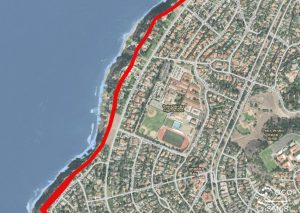Possible Cliffside Catastrophe
As climate change makes international headlines, some might wonder how it will affect their local communities. For those living on the Palos Verdes Peninsula, one consequence of the climate crisis, sea level rise, is bound to hit close to home. As climate change makes international headlines, some might wonder how it will affect their local communities. For those living on the Palos Verdes Peninsula, one consequence of the climate crisis, sea level rise, is bound to hit close to home.
Future Cliff Edge with Erosion: Cliff tops near PVHS are estimated to erode by 62 to 135 ft with 5.7 feet (175 cm) of sea-level rise, which could occur by 2100. From Our Coast Our Future (OCOF).
Due to rising levels of human emissions of carbon, affecting climate change, sea level rise is projected to accelerate at unprecedented rates.
These rises quicken erosion of the Palos Verdes Peninsula’s coastal bluffs and are estimated to threaten sea cliffs, homes and roads of and in current PV High schoolers’ lives.
Rising temperatures are causing ocean water to warm and expand, as well as glaciers and ice caps to melt. Co-president of Heal the Bay Landon Ota believes the effects of rising sea levels could be catastrophic.
“In the near future, the rising of sea levels could mean an increase in the loss of biodiversity and the displacement of houses along the beach,” Ota said.
The National Oceanic and Atmospheric Administration (NOAA) measures tides in the Los Angeles Harbor and have found that sea levels have risen by an average of 1 millimeter per year, which is equivalent to four inches in the last hundred years, showing slow progression in the past.
The California Ocean Protection Council estimates that, with today’s current rate of greenhouse gas emissions, the maximum sea level rise in the PV area could be 1.0 foot by 2030. By 2050, it may be 2.6 feet, and by 2100, 10.2 feet.
The U.S Geological Survey projects that the cliffs near PVHS may erode up to 135 feet by 2100. The threat of sea level rise will leave infrastructure vulnerable along the Palos Verdes bluffs and Los Angeles coast.
James Jackson, a coastal engineer at Environmental Science Associates, says erosion and flooding are quickly becoming local issues, as “assets like residential development to public facilities are at risk.”
The current impacts of cliff erosion on Palos Verdes include the ongoing landslide on Portuguse Bend between Teranea and Trump National Golf Course.
Rancho Palos Verdes City Councilwoman and PVHS Spanish teacher, Barbara Ferraro, is focused on addressing the landslide, but is in no hurry to address the rise in sea levels.
“We’re up on a bluff; it’s not rising significantly in any one period,” Ferraro said. “As far as I know, there are no plans to address [sea level rise]. It’s not likely to affect Rancho Palos Verdes anytime in the near future.”
Environmental engineers such as Jackson believe the imminent threat of sea level rise is an urgent matter and recommend that Palos Verdes adapt to reduce the effects of sea-level rise by “establish[ing] a monitoring plan … to respond to erosion in the event that it occurs.”
Jackson recommends considering preventing construction in areas that are most vulnerable to erosion, such as Portuguese Bend.
“The only way to fight [sea level rise] is to fight global climate change,” science teacher Marta Wood said.
Even if the general population cut all carbon emissions to zero, sea levels will continue to rise due to high emissions over the past 50 years, yet it may decrease rates for the future.
“Everybody can do something,” Wood said.
Aurora Khatibi Garrity (11) is a staff writer and member of the social media team for The Point! At PVHS, she is excited and ready for a year of growth...
